Attached files
| file | filename |
|---|---|
| 8-K - 8-K - SUNTRUST BANKS INC | a8-kbarclays9102013.htm |
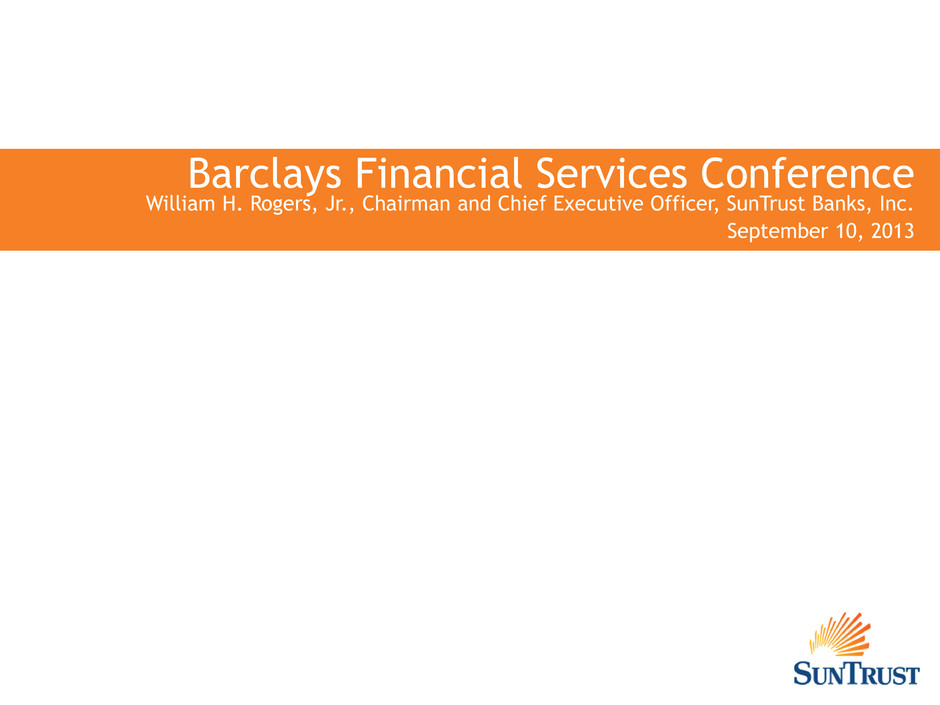
Barclays Financial Services Conference William H. Rogers, Jr., Chairman and Chief Executive Officer, SunTrust Banks, Inc. September 10, 2013

2 Important Cautionary Statement About Forward-Looking Statements The following should be read in conjunction with the financial statements, notes and other information contained in the Company’s 2012 Annual Report on Form 10-K, Quarterly Reports on Form 10-Q, and Current Reports on Form 8-K. This presentation includes non-GAAP financial measures to describe SunTrust’s performance. The reconciliations of those measures to GAAP measures are provided within or in the appendix of this presentation. In this presentation, net interest income and net interest margin are presented on a fully taxable-equivalent (“FTE”) basis, and ratios are presented on an annualized basis. The FTE basis adjusts for the tax-favored status of income from certain loans and investments. The Company believes this measure to be the preferred industry measurement of net interest income and provides relevant comparison between taxable and non-taxable amounts. This presentation may contain forward looking statements. Any statement that does not describe historical or current facts is a forward-looking statement. These statements often include the words “believes,” “expects,” “anticipates,” “estimates,” “intends,” “plans,” “goals,” “targets,” “initiatives,” “potential” or “potentially,” “probably,” “projects,” “outlook” or similar expressions or future conditional verbs such as “may,” “will,” “should,” “would,” and “could.” Such statements are based upon the current beliefs and expectations of management and on information currently available to management. Such statements speak as of the date hereof, and we do not assume any obligation to update these statements or to update the reasons why actual results could differ from those contained in such statements in light of new information or future events. Forward-looking statements are subject to significant risks and uncertainties. Investors are cautioned against placing undue reliance on such statements. Actual results may differ materially from those set forth in the forward- looking statements. Factors that could cause actual results to differ materially from those described in the forward-looking statements can be found in Item 1A of Part I of our 10-K and in other periodic reports that we file with the SEC. Those factors include: our framework for managing risks may not be effective in mitigating risk and loss to us; as one of the largest lenders in the Southeast and Mid-Atlantic U.S. and a provider of financial products and services to consumers and businesses across the U.S., our financial results have been, and may continue to be, materially affected by general economic conditions, particularly unemployment levels and home prices in the U.S., and a deterioration of economic conditions or of the financial markets may materially adversely affect our lending and other businesses and our financial results and condition; legislation and regulation, including the Dodd-Frank Act, as well as future legislation and/or regulation, could require us to change certain of our business practices, reduce our revenue, impose additional costs on us, or otherwise adversely affect our business operations and/or competitive position; we are subject to capital adequacy and liquidity guidelines and, if we fail to meet these guidelines, our financial condition would be adversely affected; loss of customer deposits and market illiquidity could increase our funding costs; we rely on the mortgage secondary market and GSEs for some of our liquidity; we are subject to credit risk; our ALLL may not be adequate to cover our eventual losses; we may have more credit risk and higher credit losses to the extent our loans are concentrated by loan type, industry segment, borrower type, or location of the borrower or collateral; we will realize future losses if the proceeds we receive upon liquidation of nonperforming assets are less than the carrying value of such assets; a downgrade in the U.S. government's sovereign credit rating, or in the credit ratings of instruments issued, insured or guaranteed by related institutions, agencies or instrumentalities, could result in risks to us and general economic conditions that we are not able to predict; the failure of the European Union to stabilize the fiscal condition and creditworthiness of its weaker member economies could have international implications potentially impacting global financial institutions, the financial markets, and the economic recovery underway in the U.S.; weakness in the real estate market, including the secondary residential mortgage loan markets, has adversely affected us and may continue to adversely affect us; we are subject to certain risks related to originating and selling mortgages, and may be required to repurchase mortgage loans or indemnify mortgage loan purchasers as a result of breaches of representations and warranties, borrower fraud, or as a result of certain breaches of our servicing agreements, and this could harm our liquidity, results of operations, and financial condition; financial difficulties or credit downgrades of mortgage and bond insurers may adversely affect our servicing and investment portfolios; we may face certain risks as a servicer of loans, or also may be terminated as a servicer or master servicer, be required to repurchase a mortgage loan or reimburse investors for credit losses on a mortgage loan, or incur costs, liabilities, fines and other sanctions if we fail to satisfy our servicing obligations, including our obligations with respect to mortgage loan foreclosure actions; we are subject to risks related to delays in the foreclosure process; we may continue to suffer increased losses in our loan portfolio despite enhancement of our underwriting policies and practices; our mortgage production and servicing revenue can be volatile; as a financial services company, changes in general business or economic conditions could have a material adverse effect on our financial condition and results of operations; changes in market interest rates or capital markets could adversely affect our revenue and expense, the value of assets and obligations, and the availability and cost of capital and liquidity; changes in interest rates could also reduce the value of our MSRs and mortgages held for sale, reducing our earnings; changes which are being considered in the method for determining LIBOR may affect the value of debt securities and other financial obligations held or issued by SunTrust that are linked to LIBOR, or may affect the Company's financial condition or results of operations; the fiscal and monetary policies of the federal government and its agencies could have a material adverse effect on our earnings; depressed market values for our stock may require us to write down goodwill; clients could pursue alternatives to bank deposits, causing us to lose a relatively inexpensive source of funding; consumers may decide not to use banks to complete their financial transactions, which could affect net income; we have businesses other than banking which subject us to a variety of risks; hurricanes and other disasters may adversely affect loan portfolios and operations and increase the cost of doing business; negative public opinion could damage our reputation and adversely impact business and revenues; we rely on other companies to provide key components of our business infrastructure; a failure in or breach of our operational or security systems or infrastructure, or those of our third party vendors and other service providers, including as a result of cyber attacks, could disrupt our businesses, result in the disclosure or misuse of confidential or proprietary information, damage our reputation, increase our costs and cause losses; the soundness of other financial institutions could adversely affect us; we depend on the accuracy and completeness of information about clients and counterparties; regulation by federal and state agencies could adversely affect the business, revenue, and profit margins; competition in the financial services industry is intense and could result in losing business or margin declines; maintaining or increasing market share depends on market acceptance and regulatory approval of new products and services; we might not pay dividends on your common stock; our ability to receive dividends from our subsidiaries could affect our liquidity and ability to pay dividends; disruptions in our ability to access global capital markets may adversely affect our capital resources and liquidity; any reduction in our credit rating could increase the cost of our funding from the capital markets; we have in the past and may in the future pursue acquisitions, which could affect costs and from which we may not be able to realize anticipated benefits; we are subject to certain litigation, and our expenses related to this litigation may adversely affect our results; we may incur fines, penalties and other negative consequences from regulatory violations, possibly even from inadvertent or unintentional violations; we depend on the expertise of key personnel, and if these individuals leave or change their roles without effective replacements, operations may suffer; we may not be able to hire or retain additional qualified personnel and recruiting and compensation costs may increase as a result of turnover, both of which may increase costs and reduce profitability and may adversely impact our ability to implement our business strategies; our accounting policies and processes are critical to how we report our financial condition and results of operations, and they require management to make estimates about matters that are uncertain; changes in our accounting policies or in accounting standards could materially affect how we report our financial results and condition; our stock price can be volatile; our disclosure controls and procedures may not prevent or detect all errors or acts of fraud; our financial instruments carried at fair value expose us to certain market risks; our revenues derived from our investment securities may be volatile and subject to a variety of risks; and we may enter into transactions with off-balance sheet affiliates or our subsidiaries.

3 Company Overview

4 Franchise Overview Who is SunTrust? Diverse Business Mix1 • A leading financial institution focused on meeting clients’ needs and improving their financial well-being • Our organization is differentiated by: — A “Client First” culture that has generated high loyalty — Being the right size—large enough to compete with anyone while still being nimble — Diversity—a strong regional bank, augmented with key national businesses — Leading market shares in high growth and densely populated markets in the Southeast and Mid-Atlantic — A new management team with increased intensity on capitalizing upon SunTrust’s strengths Leading Market Shares in Growth Markets Market Share in Respective Top 10 MSAs2 Projected Population Growth of Footprint3 1. Based on 1H 13 FTE Revenue. Other includes Corporate, institutional asset management, leasing, insurance premium financing and certain Treasury & Payment Solutions standalone client sub-segments 2. Source: SNL Financial, as of 6/30/2012 based on top 10 MSAs (by deposits) for each institution. Numerator is company’s total deposits in its Top 10 MSAs and denominator is total deposits in those 10 MSAs 3. Source: SNL Financial, at 8/26/2013, based on five-year projected change, 2012-2017. Weighted average by deposits in MSAs and counties not in any MSA Note: Peers include: BBT, COF, CMA, FITB, KEY, MTB, PNC, RF, USB, and WFC #3 of 11 #1 of 11 31% 17% 14% 11% 11% 6% 3% 7% Retail Corporate and Investment Banking Mortgage Banking Commercial and Business Banking Private Wealth Management Consumer Lending Commercial Real Estate Other 14.1% 8.5% SunTrust Peers 4.6% 3.1% SunTrust Peers
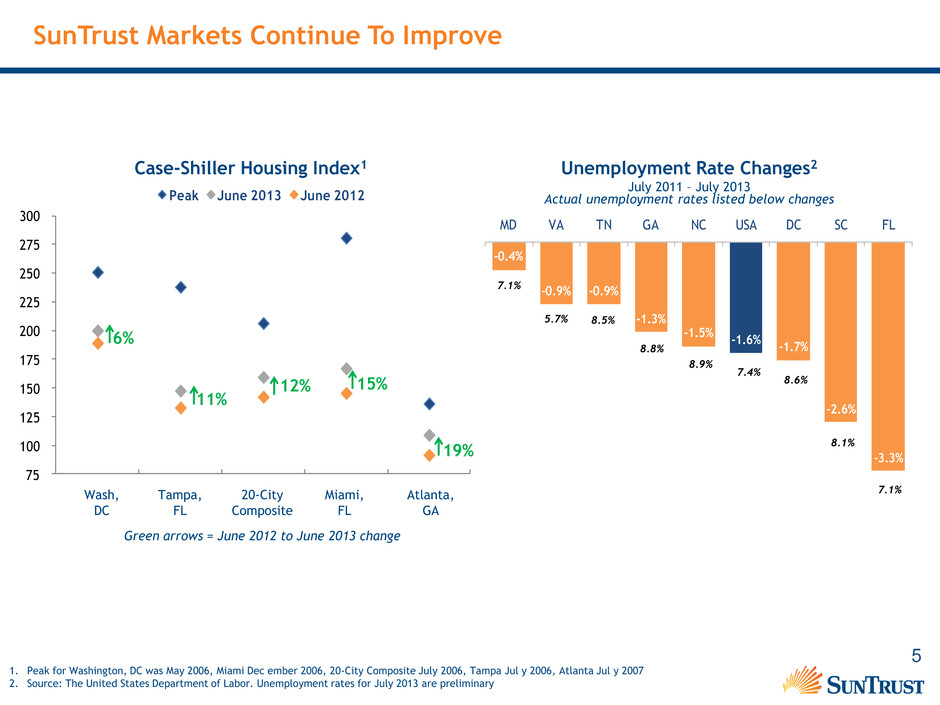
5 75 100 125 150 175 200 225 250 275 300 Peak June 2013 June 2012 -0.4% -0.9% -0.9% -1.3% -1.5% -1.6% -1.7% -2.6% -3.3% MD VA TN GA NC USA DC SC FL SunTrust Markets Continue To Improve Case-Shiller Housing Index1 1. Peak for Washington, DC was May 2006, Miami Dec ember 2006, 20-City Composite July 2006, Tampa Jul y 2006, Atlanta Jul y 2007 2. Source: The United States Department of Labor. Unemployment rates for July 2013 are preliminary Wash, DC 20-City Composite Miami, FL Tampa, FL Atlanta, GA Unemployment Rate Changes2 July 2011 – July 2013 11% 12% 15% 19% Actual unemployment rates listed below changes 7.1% 5.7% 8.5% 8.8% 8.9% 7.4% 8.6% 8.1% 7.1% Green arrows = June 2012 to June 2013 change 6%

6 Overview of Corporate Performance Profitability metrics are more favorable 1. PPNR and noninterest expense measured on an adjusted basis. See appendix for noninterest income and expense adjustment items 2. Calculated on a tangible basis and excluding certain items that are material and/or potentially nonrecurring. The GAAP efficiency ratios for 1H 12 and 1H 13 were 69.2% and 65.5%, respectively. Please refer to the appendix for the GAAP reconciliations PPNR1 Noninterest Expense1 Net Income Tangible Efficiency Ratio2 ($ in millions) $1,386 $1,462 1H 12 1H 13 $3,064 $2,760 1H 12 1H 13 $525 $729 0.59% 0.85% 1H 12 1H 13 68.4% 65.1% 1H 12 1H 13

7 $2,800 $1,395 2.24% 1.14% 2Q 12 2Q 13 Foundation Strong and Improving Credit and capital have also improved considerably Nonperforming Assets Net Charge-Offs Tier 1 Common Ratio ($ in millions) 1. Represents reported NPAs / (Loans + OREO + other repossessed assets + nonperforming LHFS) 2. Represents net charge-offs to average loans 3. Please refer to the appendix for the GAAP reconciliation Estimated Basel III Tier 1 Common Ratio = 9.5%3 9.4% 10.2% 2Q 12 2Q 13 $350 $179 1.14% 0.59% 2Q 12 2Q 13

8 $5,455 $5,124 2012 2013 $655 $396 $325 2012 2013 Estimated Normalized Level Continued Focus on Efficiency… Credit Related Expenses and Operating Losses Core Operating Costs3 1. Includes credit services, collection services, other real estate, and operating losses 2. YTD Annualized, as of June 30, 2013 3. Core Operating Costs defined as Adjusted Noninterest Expense less Credit Related Expenses and Operating Losses. Adjusted Noninterest Expense defined as reported noninterest expense less certain adjustments. Reported noninterest expense for 2012 and 1H 2013 annualized was $6,323 and $5,520, respectively. For 2012, Core Operating Costs exclude $213 in adjustment items and $655 in Credit Related Expenses and Operating Losses. For 2013, Core Operating Costs exclude $396 in annualized Credit Related Expenses and Operating Losses (there were no adjustment items in 1H 13). Please refer to the appendix for additional detail on adjustments and for GAAP reconciliations • Incorporated efficiency ratio into compensation plans • Transparency throughout all levels of the organization • Efficiency targets established for each business line and function • Raised pay-for-performance standards Moving From Efficiency Initiatives to a Culture of Efficiency… …While Still Ensuring Our Team Has Specific Action Plans in Place to Drive Down Costs • Continued digitization • Streamlining of operations and support systems throughout the organization • Increasing efficiency and productivity of corporate-wide real estate • Reducing elevated cyclical costs 2 1 2 < ($ in millions)

9 …Expected to Lead to Further Long-Term Efficiency Ratio Improvements Significant Improvements in Efficiency Ratio1 Despite Challenging Revenue Environment 72% 69% 65% <60% 2011 2012 1H 13 Long - Term Goal 1. Adjusted tangible efficiency ratio. The GAAP efficiency ratios for 2011, 2012, and first half of 2013 were 72.5%, 59.7%, and 65.5%, respectively. Please refer to the appendix for the GAAP reconciliations
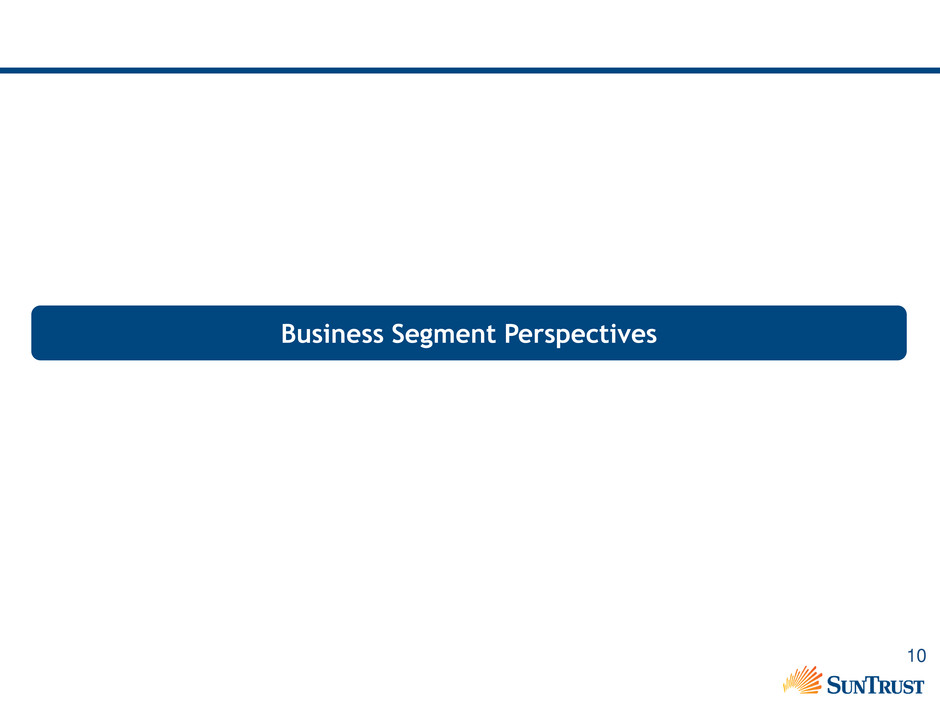
10 Business Segment Perspectives

11 Overview of Business Segments’ Growth Drivers Consumer Banking and Private Wealth Management Wholesale Banking Mortgage Banking • Continue momentum in Corporate and Investment Banking – Apply key success factors throughout rest of Wholesale Banking • Expand Commercial Real Estate business • Deepen commercial client penetration with capital markets and treasury related solutions • Respond to current environment • Resolve legacy issues • Capitalize upon purchase market opportunities • Invest in technology to further improve client service • Leverage client loyalty to drive increased productivity • Continue growth in consumer lending businesses

12 1. FTE basis 2. Source: SNL Financial, as of 6/30/2012 3. 1H 13 as compared to 1H 12 4. Provision for credit losses represents net charge-offs for the segments 5. The GAAP efficiency ratios for 1H 12 and 1H 13 were 71.8% and 68.8%, respectively. The tangible efficiency ratio excludes intangible asset amortization of 3.1% and 2.4% for 1H 12 and 1H 13, respectively • Concentrated in the more densely populated and growing Southeast and Mid-Atlantic markets • Top 3 deposit market share in 19 of our Top 25 MSAs2 • High levels of client loyalty • Net income up 36% • Provision for credit losses down 29%4 • Expenses down 9% • Tangible efficiency ratio of 66.4%, down over 200 basis points5 1H 13 Revenue Distribution¹ Key Differentiators YTD Performance Highlights3 Consumer Banking and Private Wealth Management Overview Consumer Banking and PWM 48% Retail 64% PWM 23% Consumer Lending 14%

13 June 2012 June 2013 1,661 1,539 100 82 2Q11 2Q13 68% 75% 32% 25% 2Q11 2Q13 Fewer Branch Transactions Have Enabled Branch Count and Staffing Reductions Retail Banking Key Initiatives 1. Self Service transactions include mobile, tablet, online, ATM, and EIVR (Enhanced Interactive Voice Response). Full service transactions include branch and SunTrust Online live agent 2. Indexed, 2Q11 = 100 3. Core sales represent the # of units from key product categories, including checking, savings, credit card, consumer loans/lines, investment referrals, and mortgage referrals. FTEs includes Managers, Personal Bankers, In-store FSRs and In-store Assistant Managers Branch Count Growth in Total Self Service Transactions1 Continues Self Service Full Service 2. Drive Productivity Higher Core Sales / FTE / Day3 1. Meet Clients’ Digital Needs and Manage Costs Lower 3. While Continuing to Maintain High Client Loyalty 2012 YTD 2013

14 $1,260 $1,373 2Q12 2Q13 $2,872 $3,303 2Q12 2Q13 January 2013 Launch of Simple Home Refinance Product Continues to Drive HE Loan Production Consumer Lending Demonstrating Strong Growth Indirect Auto Loan Production Consumer Lending Production ($ in millions) $199 $410 1Q13 2Q13

15 Key Differentiators YTD Performance Highlights2 Wholesale Banking Overview 1H 13 Revenue Distribution1 Corporate and Investment Banking 49% Commercial and Business Banking 31% CRE 8% Other 12% Wholesale Banking 35% • Delivery of the entire suite of products and services through one Wholesale Banking business • Unique middle market investment banking position with a comprehensive suite of products and services • Strong, stable commercial customer share (ranked 3rd within the SunTrust footprint)4 1. FTE basis. Other LOB consists of institutional asset management, leasing, insurance premium financing and certain Treasury & Payment Solutions standalone client sub-segments 2. 1H 13 as compared to 1H 12 3. The GAAP efficiency ratios for 1H 12 and 1H 13 were 60.9% and 54.1%, respectively. The tangible efficiency ratio excludes intangible asset amortization of 1.9% and 1.3% for 1H 12 and 1H 13, respectively 4. Source: 2011 Greenwich market study covering the $5 million to $100 million segment within SunTrust’s footprint. “Customer Share” represents companies that cited using a specific bank for at least one product or service • Net income up 44% • Expenses down 11% • Tangible Efficiency Ratio of 52.7%, down over 600 basis points3 • Average loans up 6% NOTE: Totals may not foot due to rounding
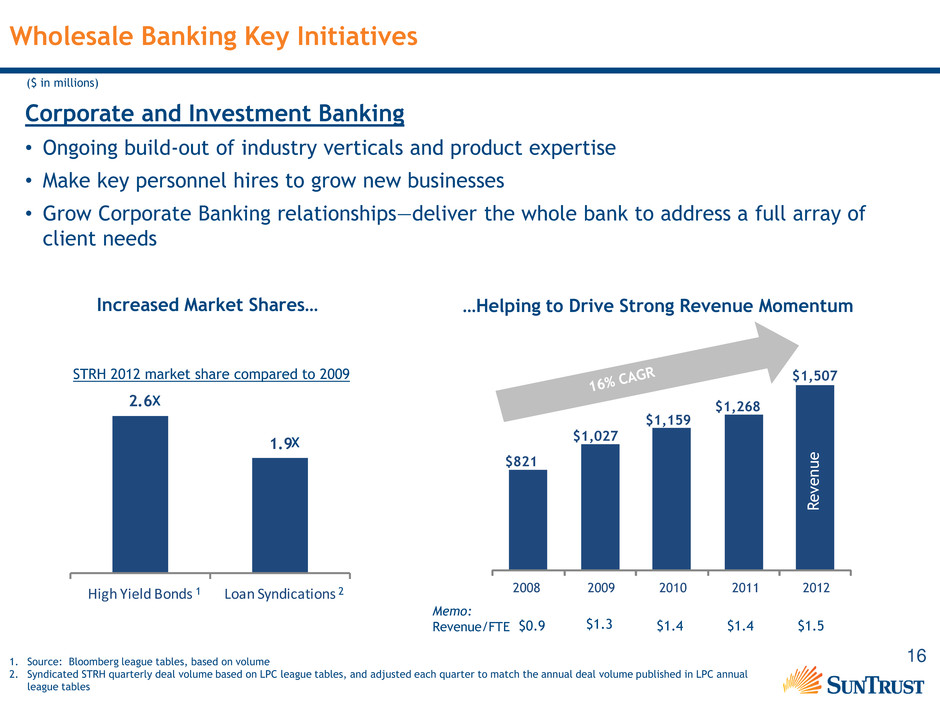
16 2.6 1.9 High Yield Bonds Loan Syndications Corporate and Investment Banking • Ongoing build-out of industry verticals and product expertise • Make key personnel hires to grow new businesses • Grow Corporate Banking relationships—deliver the whole bank to address a full array of client needs …Helping to Drive Strong Revenue Momentum Wholesale Banking Key Initiatives Increased Market Shares… Memo: Revenue/FTE $0.9 $1.3 $1.4 $1.4 $1.5 1. Source: Bloomberg league tables, based on volume 2. Syndicated STRH quarterly deal volume based on LPC league tables, and adjusted each quarter to match the annual deal volume published in LPC annual league tables ($ in millions) $821 $1,027 $1,159 $1,268 $1,507 2008 2009 2010 2011 2012 R e ve n u e X X 1 2 STRH 2012 market share compared to 2009

17 Note: Totals may not foot due to rounding • Employ targeted approach to growing retail, office, multi-family and industrial relationships • Build out REIT business, partnering with Corporate and Investment Banking to drive capital markets business with targeted clients • Pursue institutional investor opportunities • Expand Treasury and Payment services to each client segment Wholesale Banking Key Initiatives Commercial Real Estate ($ in millions) ($ in billions) $12.5 $9.7 $7.0 $5.7 $5.2 $(591) $(329) $(313) $(136) $43 2009 2010 2011 2012 YTD 2013 Net Income/(Loss) $5.3 $7.0 $5.4 $4.6 $4.5 $4.6 $4.8 $5.5 $4.3 $2.5 $1.1 $0.5 $0.5 2009 2010 2011 2012 Q 13 2Q 13 CRE Average Loan Balances Excluding Special Assets Special Assets Division Average Loan Balances

18 1. 1H 13 as compared to 1H 12 2. Ranked #3 in the 2013 JD Power Mortgage Servicing Survey, and ranked #5 in the 2012 JD Power Primary Mortgage Originations Survey Key Differentiators YTD Performance Highlights1 • Improving Southeastern housing market • Strong origination platform for agency and jumbo loans • Retail origination channel well-positioned to capture purchase volume • Ranked in Top 5 for both J.D. Power and Associates Mortgage Originator and Servicer Satisfaction Studies2 • Production volume up 13% • Expenses down 10%, though efficiency ratio remains significantly elevated at 102% • Continued channel diversity Mortgage Banking Overview 1H 13 Revenue Distribution Mortgage Banking 14% Production Related Income 49% Net Interest Income 45% Servicing Related Income 6%
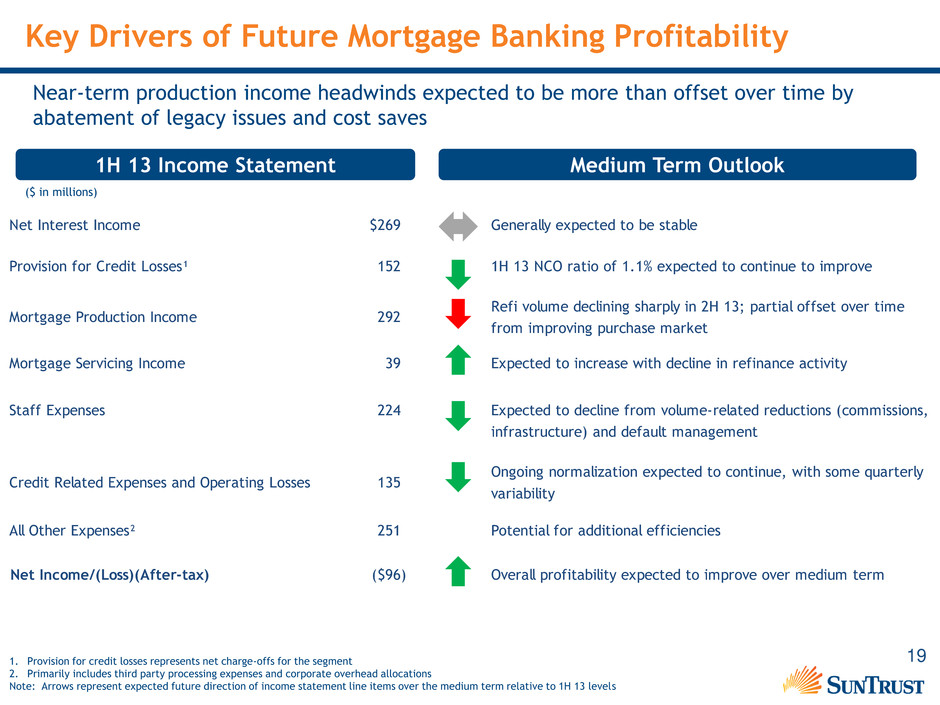
19 Net Interest Income $269 Generally expected to be stable Provision for Credit Losses¹ 152 1H 13 NCO ratio of 1.1% expected to continue to improve Mortgage Production Income 292 Refi volume declining sharply in 2H 13; partial offset over time from improving purchase market Mortgage Servicing Income 39 Expected to increase with decline in refinance activity Staff Expenses 224 Expected to decline from volume-related reductions (commissions, infrastructure) and default management Credit Related Expenses and Operating Losses 135 Ongoing normalization expected to continue, with some quarterly variability All Other Expenses² 251 Potential for additional efficiencies Net Income/(Loss)(After-tax) ($96) Overall profitability expected to improve over medium term Key Drivers of Future Mortgage Banking Profitability 1H 13 Income Statement Medium Term Outlook Near-term production income headwinds expected to be more than offset over time by abatement of legacy issues and cost saves ($ in millions) 1. Provision for credit losses represents net charge-offs for the segment 2. Primarily includes third party processing expenses and corporate overhead allocations Note: Arrows represent expected future direction of income statement line items over the medium term relative to 1H 13 levels

20 Mortgage Banking - The Transition to Purchase Purchase Trends1 • Historical orientation as purchase mortgage provider Long-term relationships with realtors and builders • Southeast purchase market demonstrating relative strength • Cash transactions represent ~40% of home purchases2—increased opportunity for Mortgage Banking as financing needs increase Key Action Steps • Pivot sales focus to purchase • Improve retail channel execution by reducing closing time • Increase penetration of mortgage product to Consumer/PWM client base SunTrust Positioning ($ in billions) $2.5 $3.0 $3.1 2Q 11 2Q 12 2Q 13 1. Represents closed loans 2. Source: RealtyTrac

21 Investment Thesis Why SunTrust? • Attractive franchise with leading market shares, robust growth trajectory, and diverse revenue streams • Markets experiencing strong recovery • On a solid path with a strong foundation from which to grow • Committed to efficiency objectives; building an efficiency-minded culture and getting results • Wholesale Banking and Consumer Banking and Private Wealth Management businesses have momentum; getting Mortgage Banking to profitability is a priority
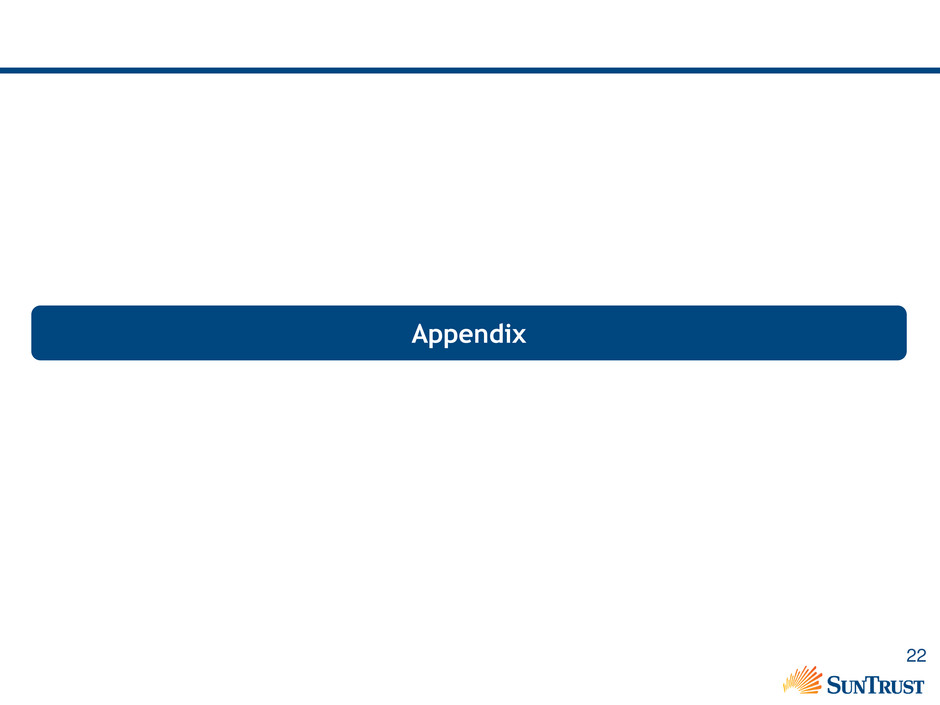
22 Appendix

23 1Q 12 2Q 12 1Q 13 2Q 13 1H 12 1H 13 2011 2012 Reported (GAAP) Basis Total Revenue - FTE [a] $2,218 $2,246 $2,114 $2,100 $4,464 $4,214 $8,600 $10,598 Total Noninterest Expense [b] 1,541 1,546 1,363 1,397 3,087 2,760 6,234 6,323 Amortization of Intangibles / Impairment of Goodwill 11 11 6 6 22 12 43 46 Efficiency Ratio 69.5% 68.8% 64.5% 66.5% 69.2% 65.5% 72.5% 59.7% Tangible Efficiency Ratio 69.0% 68.3% 64.2% 66.3% 68.7% 65.2% 72.0% 59.2% Adjusted Basis 1 Reported Revenue $2,218 $2,246 $2,114 $2,100 $4,464 $4,214 $8,600 $10,598 Adjustment Items: Securities Gains 18 14 2 - 32 2 117 1,973 3Q-4Q 12 Student / Ginnie Mae Loan Sale (Losses) - - - - - - - (92) FMV and ARS 1 1 14 3 2 17 (1) 40 Debt and SILC Valuation (22) (2) (24) 8 (23) (16) 89 (94) Fair Value Adjustments (1) 6 (3) (7) 5 (11) (10) 15 HARP 2.0 MSR Valuation Adjustment - - - - - - (38) - Adjusted Revenue [c] $2,223 $2,226 $2,125 $2,097 $4,449 $4,223 $8,442 $8,756 Reported Noninterest Expense $1,541 $1,546 $1,363 $1,397 $3,087 $2,760 $6,234 $6,323 Adjustment Items: Affordable Housing Writedown - - - - - - 10 96 Charitable Contribution of KO Shares - - - - - - - 38 Real Estate Charge - - - - - - - 17 Goodwill Impairment - - - - - - - 7 (Gain) / Loss on Debt Extinguishment - 13 - - 13 - (3) 15 Pension Curtailment, Net of 401(k) Contribution - - - - - - (60) - Severance 10 1 - - 11 - 27 40 Potential Mortgage Servicing Settlement - - - - - - 120 - Adjusted Expense [d] $1,531 $1,532 $1,363 $1,397 $3,064 $2,760 $6,140 $6,110 Pre-Provision Net Revenue - Reported Basis [a-b] $677 $700 $751 $703 $1,377 $1,454 $2,366 $4,275 Pre-Provision Net Revenue - Adjusted Basis [c-d] $692 $694 $762 $700 $1,386 $1,462 $2,303 $2,646 Efficiency Ratio - Adjusted Basis 68.9% 68.8% 64.1% 66.6% 68.9% 65.4% 72.7% 69.8% Tangible Efficiency Ratio - Adjusted Basis 68.4% 68.3% 63.8% 66.3% 68.4% 65.1% 72.2% 69.3% Non-GAAP Efficiency Ratio and Adjusted Basis Reconciliations 1. Adjusted revenue and expenses are provided as they remove certain items that are material and/or potentially non-recurring. Adjusted figures are intended to provide management and investors information on trends that may be more easily compared to other institutions NOTE: Totals may not foot due to rounding ($ in millions)

24 Reconciliation of Tier 1 Common Equity Ratio1 2Q 13 Tier 1 Common Equity - Basel I $14.2 Adjustments from Basel I to Basel III 2 --- Tier 1 Common Equity - Basel III 3 $14.2 Risk-weighted Assets - Basel I $139.0 Adjustments from Basel I to Basel III 4 9.7 Risk-weighted Assets - Basel III 3 $148.7 Tier 1 Common Equity Ratio Basel I 10.2% Basel III 3 9.5% ($ in billions) 1. The Tier 1 common equity ratio is a financial measure that is used by regulators, bank management, and investors to assess the capital position of financial services companies. The Tier 1 common equity ratio as calculated for Basel III is considered non-GAAP, and as such we have presented a reconciliation to the Tier 1 common equity ratio under Basel I that is currently used by regulators. All figures are estimated at the time of the earnings release and subject to revision 2. Improved treatment of mortgage servicing assets essentially offset by disallowed deferred tax assets 3. The Basel III calculations of Tier 1 common equity, risk-weighted assets, and the Tier 1 common equity ratio are based upon the Company's interpretation of the final Basel III rules issued by the Federal Reserve on July 2, 2013, on a fully-phased-in basis. The Company's interpretation of the rules is subject to change, and as such, so are its estimated Basel III calculations 4. The largest differences between the risk-weighted assets as calculated under Basel I versus Basel III for SunTrust relate to the risk-weightings for certain commercial loans, unfunded commitments and mortgage servicing assets NOTE: Totals may not foot due to rounding

Barclays Financial Services Conference William H. Rogers, Jr., Chairman and Chief Executive Officer, SunTrust Banks, Inc. September 10, 2013
